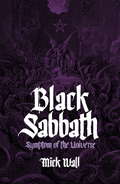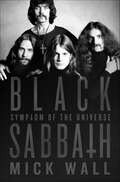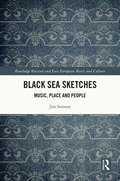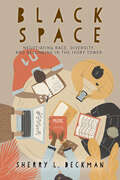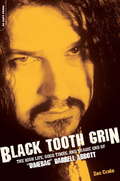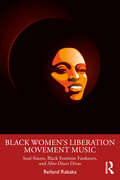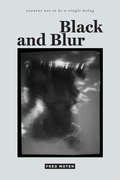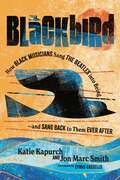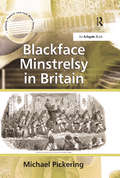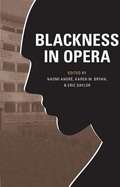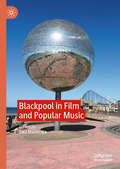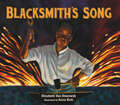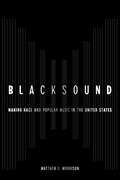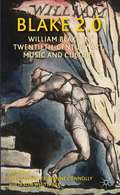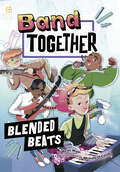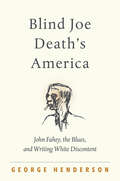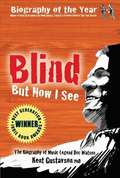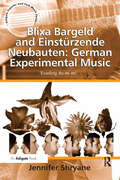- Table View
- List View
Black Sabbath and the Rise of Heavy Metal Music (Ashgate Popular and Folk Music Series)
by Andrew L. CopeThe definition of 'heavy metal' is often a contentious issue and in this lively and accessible text Andrew Cope presents a refreshing re-evaluation of the rules that define heavy metal as a musical genre. Cope begins with an interrogation of why, during the late 1960s and early 1970s, Birmingham provided the ideal location for the evolution and early development of heavy metal and hard rock. The author considers how the influence of the London and Liverpool music scenes merged with the unique cultural climate, industry and often desolated sites of post-war Birmingham to contribute significantly to the development of two unique forms of music: heavy metal and hard rock. The author explores these two forms through an extensive examination of key tracks from the first six albums of both Black Sabbath and Led Zeppelin, in which musical, visual and lyrical aspects of each band are carefully compared and contrasted in order to highlight the distinctive innovations of those early recordings. In conclusion, a number of case studies are presented that illustrate how the unique synthesis of elements established by Black Sabbath have been perpetuated and developed through the work of such bands as Iron Maiden, Metallica, Pantera, Machine Head, Nightwish, Arch Enemy and Cradle of Filth. As a consequence, the importance of heavy metal as a genre of music was firmly established, and its longevity assured.
Black Sabbath: Symptom of the Universe
by Mick Wall'An epic tale, told the way it should be' RECORD COLLECTOR'The book he was born to write' CLASSIC ROCK MAGAZINE'An entertaining read for long-standing fans and newcomers alike' GUITARISTThe final word on the only name synonymous with heavy metal - Black Sabbath.Way back in the mists of time, in the days when rock giants walked the earth, the name Ozzy Osbourne was synonymous with the subversive and dark. Back then, Ozzy was the singer in Black Sabbath, and they meant business. A four-piece formed from the ashes of two locally well-known groups called The Rare Breed (Ozzy and bassist Geezer Butler) and Mythology (guitarist Tony Iommi and drummer Bill Ward), all four founding members of the original Black Sabbath grew up within half-a-mile of each other.This biography tells the story of how they made that dream come true - and how it then turned into a nightmare for all of them. How at the height of their fame, Sabbath discovered they had been so badly ripped off by their managers they did not even own their own songs. How they looked for salvation from Don Arden - an even more notorious gangster figure, who resurrected their career but still left them indebted to him, financially and personally. And how it finally came to a head when in 1979 they sacked Ozzy: 'For being too out of control - even for us,' as Bill Ward put it.The next 15 years would see a war break out between the two camps: the post-Ozzy Sabbath and Ozzy himself, whose solo career overshadowed Sabbath to the point where, when he offered them the chance to reform around him again, it was entirely on his terms. Or rather, that of his wife and manager, daughter of Don Arden - Sharon Osbourne.
Black Sabbath: Symptom of the Universe
by Mick Wall'An epic tale, told the way it should be' RECORD COLLECTOR'The book he was born to write' CLASSIC ROCK MAGAZINE'An entertaining read for long-standing fans and newcomers alike' GUITARISTThe final word on the only name synonymous with heavy metal - Black Sabbath.Way back in the mists of time, in the days when rock giants walked the earth, the name Ozzy Osbourne was synonymous with the subversive and dark. Back then, Ozzy was the singer in Black Sabbath, and they meant business. A four-piece formed from the ashes of two locally well-known groups called The Rare Breed (Ozzy and bassist Geezer Butler) and Mythology (guitarist Tony Iommi and drummer Bill Ward), all four founding members of the original Black Sabbath grew up within half-a-mile of each other.This biography tells the story of how they made that dream come true - and how it then turned into a nightmare for all of them. How at the height of their fame, Sabbath discovered they had been so badly ripped off by their managers they did not even own their own songs. How they looked for salvation from Don Arden - an even more notorious gangster figure, who resurrected their career but still left them indebted to him, financially and personally. And how it finally came to a head when in 1979 they sacked Ozzy: 'For being too out of control - even for us,' as Bill Ward put it.The next 15 years would see a war break out between the two camps: the post-Ozzy Sabbath and Ozzy himself, whose solo career overshadowed Sabbath to the point where, when he offered them the chance to reform around him again, it was entirely on his terms. Or rather, that of his wife and manager, daughter of Don Arden - Sharon Osbourne.
Black Sabbath: Symptom of the Universe
by Mick WallDecades before reality television was invented, Ozzy Osbourne was subversive and dark. Ozzy was the singer in the heavy metal band Black Sabbath, and they meant business. In an era when rock bands were measured by how 'heavy' they were, no one was weightier than Black Sabbath. All four founding members of the original Black Sabbath grew up within half-a-mile of each other in a tiny Birmingham suburb. Though all shared a deep love of music--The Beatles for Ozzy, the Mothers of Invention for Geezer, the Shadows and Chet Atkins for Iommi, and Gene Kruppa for Ward— they formed their group "as the quickest way out of the slums." This is the story of how they made that dream come true--and how it then turned into a nightmare for all of them. At the height of their fame, Sabbath discovered they'd been so badly ripped off by their managers they didn't even own their own songs. They looked for salvation from Don Arden—an even more notorious gangster figure, who resurrected their career but still left them indebted to him, financially and personally. It finally came to a head when in 1979 they sacked Ozzy: "For being too out of control--even for us," as Bill Ward put it. The next fifteen years were a war between the post-Ozzy Sabbath and Ozzy himself, whose solo career overshadowed Sabbath so much that a reunion was entirely on his terms. Or rather, those of his wife and manager—to add a further bitter twist for Sabbath, daughter of Don Arden —Sharon Osbourne.
Black Sea Sketches: Music, Place and People (Routledge Russian and East European Music and Culture)
by Jim SamsonBlack Sea Sketches is a portrait of some of the diverse musical cultures surrounding the Black Sea and in its hinterlands. Its six separate chapters follow a very broad trajectory from close-ups of traditional music (chapters 1-4) towards wide-angle studies of art music (chapters 5-6), and each of them opens windows to big, border-crossing themes about music and place. A wide variety of repertoires is discussed: ancient layers of polyphonic music, bardic songs, traditional music from the coasts and mountains, the sacred music of Islam and Orthodox Christianity, the art music of Europe and West Asia, and present-day popular music ‘scenes’. The usual practice is for each chapter to begin with a Black Sea coastal location before reaching out into the hinterlands. The result is a collection of six relatively discrete essays on different locations and topics, but with underlying thematic continuities, and offering a wide-ranging commentary on cultural difference. Firmly grounded in ethnographic and documentary research, this is an important study for scholars and researchers of Ethnomusicology, as also of Caucasian and Russian/East European Studies.
Black Space: Negotiating Race, Diversity, and Belonging in the Ivory Tower (The American Campus)
by Sherry L. DeckmanProtests against racial injustice and anti-Blackness have swept across elite colleges and universities in recent years, exposing systemic racism and raising questions about what it means for Black students to belong at these institutions. In Black Space, Sherry L. Deckman takes us into the lives of the members of the Kuumba Singers, a Black student organization at Harvard with racially diverse members, and a self-proclaimed safe space for anyone but particularly Black students. Uniquely focusing on Black students in an elite space where they are the majority, Deckman provides a case study in how colleges and universities might reimagine safe spaces. Through rich description and sharing moments in students’ everyday lives, Deckman demonstrates the possibilities and challenges Black students face as they navigate campus culture and the refuge they find in this organization. This work illuminates ways administrators, faculty, student affairs staff, and indeed, students themselves, might productively address issues of difference and anti-Blackness for the purpose of fostering critically inclusive campus environments.
Black Tooth Grin: The High Life, Good Times, and Tragic End of "Dimebag" Darrell Abbott
by Zac CrainBlack Tooth Grin is the first biography of "Dimebag" Darrell Abbott, the Texas-bred guitarist of the heavy metal band Pantera, who was murdered onstage in 2004 by a deranged fan-24 years to the day after John Lennon met a similar fate.Darrell Abbott began as a Kiss-inspired teenage prodigy who won dozens of local talent contests. With his brother, drummer Vinnie Abbott, he formed Pantera, becoming one of the most popular bands of the '90s and selling millions of albums to an intensely devoted fan base. While the band's music was aggressive, "Dime" was outgoing, gregarious, and adored by everyone who knew him.From Pantera's heyday to their implosion following singer Phil Anselmo's heroin addiction to Darrell's tragic end, Black Tooth Grin is a moving portrait of a great artist.
Black Women's Liberation Movement Music: Soul Sisters, Black Feminist Funksters, and Afro-Disco Divas
by Reiland RabakaBlack Women’s Liberation Movement Music argues that the Black Women’s Liberation Movement of the mid-to-late 1960s and 1970s was a unique combination of Black political feminism, Black literary feminism, and Black musical feminism, among other forms of Black feminism. This book critically explores the ways the soundtracks of the Black Women’s Liberation Movement often overlapped with those of other 1960s and 1970s social, political, and cultural movements, such as the Black Power Movement, Women’s Liberation Movement, and Sexual Revolution. The soul, funk, and disco music of the Black Women’s Liberation Movement era is simultaneously interpreted as universalist, feminist (in a general sense), and Black female-focused. This music’s incredible ability to be interpreted in so many different ways speaks to the importance and power of Black women’s music and the fact that it has multiple meanings for a multitude of people. Within the worlds of both Black Popular Movement Studies and Black Popular Music Studies there has been a long-standing tendency to almost exclusively associate Black women’s music of the mid-to-late 1960s and 1970s with the Black male-dominated Black Power Movement or the White female-dominated Women’s Liberation Movement. However, this book reveals that much of the soul, funk, and disco performed by Black women was most often the very popular music of a very unpopular and unsung movement: The Black Women’s Liberation Movement. Black Women’s Liberation Movement Music is an invaluable resource for students, teachers, and researchers of Popular Music Studies, American Studies, African American Studies, Critical Race Studies, Gender Studies, and Sexuality Studies.
Black and Blur
by Fred Moten"Taken as a trilogy, consent not to be a single being is a monumental accomplishment: a brilliant theoretical intervention that might be best described as a powerful case for blackness as a category of analysis."—Brent Hayes Edwards, author of Epistrophies: Jazz and the Literary Imagination In Black and Blur—the first volume in his sublime and compelling trilogy consent not to be a single being—Fred Moten engages in a capacious consideration of the place and force of blackness in African diaspora arts, politics, and life. In these interrelated essays, Moten attends to entanglement, the blurring of borders, and other practices that trouble notions of self-determination and sovereignty within political and aesthetic realms. Black and Blur is marked by unlikely juxtapositions: Althusser informs analyses of rappers Pras and Ol' Dirty Bastard; Shakespeare encounters Stokely Carmichael; thinkers like Kant, Adorno, and José Esteban Muñoz and artists and musicians including Thornton Dial and Cecil Taylor play off each other. Moten holds that blackness encompasses a range of social, aesthetic, and theoretical insurgencies that respond to a shared modernity founded upon the sociological catastrophe of the transatlantic slave trade and settler colonialism. In so doing, he unsettles normative ways of reading, hearing, and seeing, thereby reordering the senses to create new means of knowing.
Blackbird: How Black Musicians Sang the Beatles into Being—and Sang Back to Them Ever After (American Music History)
by Katie Kapurch Jon Marc SmithFrom the beginning, the Beatles acknowledged in interviews their debt to Black music, apparent in their covers of and written original songs inspired by Chuck Berry, Little Richard, Fats Domino, the Shirelles, and other giants of R&B. Blackbird goes deeper, appreciating unacknowledged forerunners, as well as Black artists whose interpretations keep the Beatles in play.Drawing on interviews with Black musicians and using the song “Blackbird” as a touchstone, Katie Kapurch and Jon Marc Smith tell a new history. They present unheard stories and resituate old ones, offering the phrase “transatlantic flight” to characterize a back-and-forth dialogue shaped by Black musicians in the United States and elsewhere, including Liverpool. Kapurch and Smith find a lineage that reaches back to the very origins of American popular music, one that involves the original twentieth-century blackbird, Florence Mills, and the King of the Twelve String, Lead Belly. Continuing the circular flight path with Nina Simone, Billy Preston, Jimi Hendrix, Aretha Franklin, Sylvester, and others, the authors take readers into the twenty-first century, when Black artists like Bettye LaVette harness the Beatles for today.Detailed, thoughtful, and revelatory, Blackbird explores musical and storytelling legacies full of rich but contested symbolism. Appealing to those interested in developing a deep understanding of the evolution of popular music, this book promises that you’ll never hear “Blackbird”—and the Beatles—the same way again.
Blackface Minstrelsy in Britain (Ashgate Popular And Folk Music Ser.)
by Michael PickeringBlackface minstrelsy is associated particularly with popular culture in the United States and Britain, yet despite the continual two-way flow of performers, troupes and companies across the Atlantic, there is little in Britain to match the scholarship of blackface studies in the States. This book concentrates on the distinctively British trajectory of minstrelsy. The historical study and cultural analysis of minstrelsy is important because of the significant role it played in Britain as a form of song, music and theatrical entertainment. Minstrelsy had a marked impact on popular music, dance and other aspects of popular culture, both in Britain and the United States. Its impact in the United States fed into significant song and music genres that were assimilated in Britain, from ragtime and jazz onwards, but prior to these influences, minstrelsy in Britain developed many distinct features and was adapted to operate within various conventions, themes and traditions in British popular culture. Pickering provides a convincing counter-argument to the assumption among writers in the United States that blackface was exclusively American and its British counterpart purely imitative. Minstrelsy was not confined to its value as song, music and dance. Jokes at the expense of black people along with demeaning racial stereotypes were integral to minstrel shows. As a form of popular entertainment, British minstrelsy created a cultural low-Other that offered confirmation of white racial ascendancy and imperial dominion around the world. The book attends closely to how this influence on colonialism and imperialism operated and proved ideologically so effective. At the same time British minstrelsy cannot be reduced to its racist and imperialist connections. Enormously important as those connections are, Pickering demonstrates the complexity of the subject by insisting that the minstrel show and minstrel performers are understood also in terms of their own theatrical dynamics, t
Blackness in Opera
by Guthrie Ramsey Eric Saylor Karen M. Bryan Naomi AndreBlackness in Opera critically examines the intersections of race and music in the multifaceted genre of opera. A diverse cross-section of scholars places well-known operas (Porgy and Bess, Aida, Treemonisha) alongside lesser-known works such as Frederick Delius's Koanga, William Grant Still's Blue Steel, and Clarence Cameron White's Ouanga! to reveal a new historical context for re-imagining race and blackness in opera. The volume brings a wide-ranging, theoretically informed, interdisciplinary approach to questions about how blackness has been represented in these operas, issues surrounding characterization of blacks, interpretation of racialized roles by blacks and whites, controversies over race in the theatre and the use of blackface, and extensions of blackness along the spectrum from grand opera to musical theatre and film. In addition to essays by scholars, the book also features reflections by renowned American tenor George Shirley. Contributors are Naomi André, Melinda Boyd, Gwynne Kuhner Brown, Karen M. Bryan, Melissa J. de Graaf, Christopher R. Gauthier, Jennifer McFarlane-Harris, Gayle Murchison, Guthrie P. Ramsey Jr., Eric Saylor, Sarah Schmalenberger, Ann Sears, George Shirley, and Jonathan O. Wipplinger.
Blackpool in Film and Popular Music
by Ewa MazierskaThis collection examines Blackpool, Britain’s first and largest working-class seaside resort as a location for the production and consumption of British film and popular music, and the meaning of ‘Blackpool’ in films and songs. It examines representation of Blackpool in films such as Hindle Wakes, A Taste of Honey, Bhaji on the Beach, Away, Bob’s Weekend, The Harry Hill Movie and Miss Peregrine's Home for Peculiar Children, linking it to the concepts of heterotopia, purgatory, fantasy, simulacra and the carnivalesque. It also presents music in Blackpool through the history of its venues and examines development of punk and grime music in this seaside town. The authors argue that Blackpool in filmic and musical texts often stands for British culture, but increasingly for culture which is remembered or imagined rather than present and real.
Blacksmith's Song
by Elizabeth Van SteenwykThe son of an enslaved blacksmith learns that his father is using the rhythm of his hammering to communicate with travelers on the Underground Railroad. When Pa falls ill, it's up to his son to help others along the journey―and also lead his family to freedom.Pa works hard as a blacksmith. But he's got another important job to do as well: using his anvil to pound out the traveling rhythm―a message to travelers on the Underground Railroad. His son wants to help, but Pa keeps putting him off. Then one day, Pa falls ill, and the boy has to take over.A little-known piece of history comes to life in Elizabeth Van Steenwyk's absorbing story, exquisitely illustrated by Anna Rich. Ripe with themes of bravery, community, family, freedom, and hope, this award-winning book is perfect for Black and Civil War-era history units
Blacksound: Making Race and Popular Music in the United States
by Matthew D. MorrisonA new concept for understanding the history of the American popular music industry. Blacksound explores the sonic history of blackface minstrelsy and the racial foundations of American musical culture from the early 1800s through the turn of the twentieth century. With this namesake book, Matthew D. Morrison develops the concept of "Blacksound" to uncover how the popular music industry and popular entertainment in general in the United States arose out of slavery and blackface. Blacksound as an idea is not the music or sounds produced by Black Americans but instead the material and fleeting remnants of their sounds and performances that have been co-opted and amalgamated into popular music. Morrison unpacks the relationship between performance, racial identity, and intellectual property to reveal how blackface minstrelsy scripts became absorbed into commercial entertainment through an unequal system of intellectual property and copyright laws. By introducing this foundational new concept in musicology, Blacksound highlights what is politically at stake—for creators and audiences alike—in revisiting the long history of American popular music.
Blake 2.0
by Steve Clark Tristanne Connolly Jason WhittakerBlake said of his works, 'Tho' I call them Mine I know they are not Mine'. So who owns Blake? Blake has always been more than words on a page. This volume takes Blake 2. 0 as an interactive concept, examining digital dissemination of his works and reinvention by artists, writers, musicians, and filmmakers across a variety of twentieth-century media.
Blake Shelton (Amazing Americans: Country Music Stars)
by Jim GigliottiBlake Shelton is a country music superstar. In this fascinating introduction, young readers will learn about Blake's childhood in Oklahoma and how he achieved his dream of becoming a country music icon. Each 24-page book in this series of introductory biographies features controlled text with age-appropriate vocabulary and simple sentence construction.
Blast from the Past (Star Power)
by Catherine HapkaIs Samantha who she says she is? While on tour in Switzerland, Star meets a girl named Samantha. Sam explains that she and Star went to kindergarten together before Sam's family moved away to Europe. Star doesn't really remember Sam, but Sam seems to have lots of fond memories of Star's parents, and that's a topic Star never gets tired of discussing. Soon Star and Sam are virtually inseparable. But Mike and Mags are suspicious of Star's friend's motives. Is Sam really a blast from Star's past, or is she after something more than memories?
Blended Beats (Band Together)
by Keith WainAfter a disappointing gig, Zeedee is inspired. She’s ready to add a new mood to their sound. Hopefully the other band members will agree!
Blind Joe Death's America: John Fahey, the Blues, and Writing White Discontent
by George HendersonFor over sixty years, American guitarist John Fahey (1939–2001) has been a storied figure, first within the folk and blues revival of the long 1960s, later for fans of alternative music. Mythologizing himself as Blind Joe Death, Fahey crudely parodied white middle-class fascination with African American blues, including his own. In this book, George Henderson mines Fahey's parallel careers as essayist, notorious liner note stylist, musicologist, and fabulist for the first time. These vocations, inspired originally by Cold War educators' injunction to creatively express rather than suppress feelings, took utterly idiosyncratic and prescient turns.Fahey voraciously consumed ideas: in the classroom, the counterculture, the civil rights struggle, the new left; through his study of philosophy, folklore, African American blues; and through his experience with psychoanalysis and southern paternalism. From these, he produced a profoundly and unexpectedly refracted vision of America. To read Fahey is to vicariously experience devastating critical energies and self-soothing uncertainty, passions emerging from a singular location—the place where lone, white rebel sentiment must regard the rebellion of others. Henderson shows the nuance, contradictions, and sometimes brilliance of Fahey's words that, though they were never sung to a tune, accompanied his music.
Blind but Now I See: The Biography of Music Legend Doc Watson
by Kent Gustavson<P>From the day Doc Watson stepped off the bus in New York City, the North Carolina music legend changed the world forever. His influence has been recognised by presidents and by the heroes of modern music. This is the first comprehensive biography of Doc Watson, with never before released details about the American guitar icons life. <P>This book includes new interviews with popular musicians: Ben Harper, Michelle Shocked, Warren Haynes, Sam Bush, Bela Fleck, Tom Paxton, Maria Muldaur, John Cohen, Mike Seeger, Peggy Seeger, Abigail Washburn, Ketch Secor, Marty Stuart, Norman Blake, Tony Rice, Pat Donohue, Peter Rowan, Si Kahn, Tommy Emmanuel, Tony Trischka, Greg Brown, Guy Clark, Don Rigsby, David Grisman, Alice Gerrard, Alan O Bryant, Edgar Meyer, Guy Davis, Jack Lawrence, Tao Rodriguez-Seeger, Jean Ritchie, Jerry Douglas, Jonathan Byrd, Larry Long, Paddy Moloney, and many more. . .
Blixa Bargeld and Einstürzende Neubauten: 'Evading do-re-mi' (Ashgate Popular and Folk Music Series)
by Jennifer ShryaneAt the end of his life, Pierre Schaeffer commented that his musical and sound experiments had attempted to go beyond 'do-re-mi'. This had a direct bearing on Einstürzende Neubauten's musical philosophy and work, with the musicians always striving to extend the boundaries of music in sound, instrumentation and purpose. The group are one of the few examples of 'rock-based' artists who have been able to sustain a breadth and depth of work in a variety of media over a number of years while remaining experimental and open to development. Jennifer Shryane provides a much-needed analysis of the group's important place in popular/experimental music history. She illustrates their innovations with found- and self-constructed instrumentation, their Artaudian performance strategies and textual concerns, as well as their methods of independence. Einstürzende Neubauten have also made a consistent and unique contribution to the development of the independent German Language Contemporary Music scene, which although often acknowledged as influential, is still rarely examined.
Blon (edición pack con: Eternamente | Hemisferios)
by Pablo Pérez Rueda (Blon)Descubre los dos primeros poemarios de Blon, ahora reunidos en este exclusivo pack. Eternamente es una declaración de intenciones, un intento de carta de amor incombustible a las cosas que, sin remedio, se acaban; a la persona que quieres que esté, aun corriendo el riesgo de que un día se marche. "Lo que creemos juntos no durará siempre, todo se acaba, pero seguirá en el recuerdo eternamente". Hemisferios, sin embargo, se centra en mostrar las distintas miradas, las caleidoscópicas visiones que los seres humanos tenemos de la realidad y que, sorprendentemente, llegan a viajar de un extremo al otro, desde la oscuridad a la luz o viceversa, descubriéndonos que la verdad depende del ojo desde el que se mira. Este estuche reúne los dos poemarios de Pablo Pérez Rueda, más conocido como Blon, una de las voces más importantes del rap, el freestyle y también de la poesía actual. Sus versos se mueven entre lo cotidiano y lo emocional, con un toque filosófico y social que apela a la actualidad y a nuestro mundo más inmediato. Están repletos de emoción y talento, trascendiendo el ritmo urbano de su música para convertirse en algo distinto y original: pura poesía.
Blood Harmony: The Everly Brothers Story
by Barry MazorThe definitive biography of the Everly Brothers, one of the greatest and most influential acts in popular music history, based on dozens of exclusive and archival interviews, as well as long-lost global reporting In between the Elvis years and the rise of the Beatles, there was no bigger act than The Everly Brothers. From 1957-1962, they were among the highest selling pop acts in the U.S. In that time, they developed their own brand of rock &‘n' roll and gentle pop balladry that leaned heavily on older, close harmony styles of country music singing. &“Wake Up, Little Susie,&” &“All I Have to Do Is Dream,&” &“Cathy&’s Clown,&” &“Let it Be Me,&” — their hits were legion and their sweet and sour Appalachian-style harmonies influenced everyone from The Beatles to Simon and Garfunkel to the Beach Boys to Crosby, Stills, and Nash. The Everly Brothers—Don and Phil—are inducted members of both the Rock and Roll Hall of Fame and the Country Music Hall of Fame, and progenitors of the hybrid Americana roots music format. Blood Harmony: The Everly Brothers Story is the first biography that&’s focused on the dramatic, complicated relationship of these two famous and strikingly talented brothers, and explores how the evolution of their relationship played out in the much- loved music they created—through some sixty years of performing. Their story is the story of American music, from their rural Kentucky origins to massive international fame, falling out of fashion in the wake of the rise of rock bands and singer-songwriters, and their many comebacks. Blood Harmony is a fitting ode to the brothers who made a huge impact on the modern music scene, celebrating how their creative "blood harmony" evolved to become an entry point into country music for millions around the world.
Blood in the Tracks: The Minnesota Musicians behind Dylan's Masterpiece
by Rick Shefchik Paul MetsaThe story of the Minneapolis musicians who were unexpectedly summoned to re-record half of the songs on Bob Dylan's most acclaimed album When Bob Dylan recorded Blood on the Tracks in New York in September 1974, it was a great album. But it was not the album now ranked by Rolling Stone as one of the ten best of all time. &“When something&’s not right, it&’s wrong,&” as Dylan puts it in &“You&’re Gonna Make Me Lonesome When You Go&”—and something about that original recording led him to a studio in his native Minnesota to re-record five songs, including &“Idiot Wind&” and &“Tangled Up in Blue.&” Six Minnesota musicians participated in that two-night recording session at Sound 80, bringing their unique sound to some of Dylan&’s best-known songs—only to have their names left off the album and their contribution unacknowledged for more than forty years. This book tells the story of those two nights in Minneapolis, introduces the musicians who gave the album so much of its ultimate form and sound, and describes their decades-long fight for recognition. Blood in the Tracks takes readers behind the scenes with these &“mystery&” Minnesota musicians: twenty-one-year-old mandolin virtuoso Peter Ostroushko; drummer Bill Berg and bass player Billy Peterson, the house rhythm section at Sound 80; progressive rock keyboardist Gregg Inhofer; guitarist Chris Weber, who owned The Podium guitar shop in Dinkytown; and Kevin Odegard, whose own career as a singer-songwriter had paralleled Dylan&’s until he had to take a job as a railroad brakeman to make ends meet. Through in-depth interviews and assiduous research, Paul Metsa and Rick Shefchik trace the twists of fate that brought these musicians together and then set them on different paths in its wake: their musical experiences leading up to the December 1974 recording session, the divergent careers that followed, and the painstaking work required to finally obtain the official credit that they were due. A rare look at the making—or remaking—of an all-time great album, and a long overdue recognition of the musicians who made it happen, Blood in the Tracks brings to life a transformative moment in the history of rock and roll, for the first time in its true context and with its complete cast of players.

